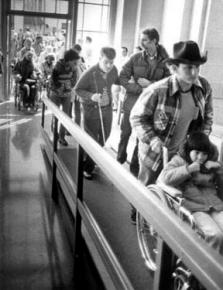We want rights, not charity
Thirty-five years ago, disability rights activists turned up the heat on the Carter administration to demand an end to discrimination, recounts .
IN APRIL of 1977, disability rights activists lost their patience with the red tape that prevented meaningful and enforceable rights for people with disabilities.
Section 504 of the Rehabilitation Act had been languishing for nearly four years, signed into law, but without clear guidelines issued to guarantee enforcement. Without these, the law requiring access to education, housing, employment, buildings and transportation for the people with disabilities was toothless.
Shortly before midnight on April 3, a group of activists held a vigil outside the Washington, D.C., home of Joseph Califano, the Carter administration's Secretary of Health, Education and Welfare (HEW). Three days later, hundreds of activists took over offices in eight cities to put force behind their demands for the Rehabilitation Act to be implemented. Some 300 activists took over Califano's Washington office for 28 hours. A few dozen spent a day sitting in at offices in other cities.
The most militant action took place in San Francisco, where 120 activists occupied the HEW office in the city's Federal Building for 25 days and nights, the longest occupation of a federal building.

Protester Mary Jane Owen recalled that at first, the occupiers were "furious at the condescending treatment from the HEW office officials, who served them cookies and punch, as if they were schoolchildren on a field trip."
But the initial welcome quickly turned colder. HEW staff attempted to drive out the activists by denying them access to their care providers and equipment like back-up ventilators. They cut off phone lines and refused to allow food into the occupied areas of the building. Without medical care and equipment, many of the activists had their lives on the line.
The support that the occupation received from the community was a decisive factor in its ability to withstand this pressure for four weeks. The largest organization participating in the protest, the Berkeley Center for Independent Living, was well connected with the Bay Area activist community. Food donated by unions and civil rights groups was prepared and brought in by the Black Panthers.
The Butterfly Brigade, a street patrol to combat anti-gay violence, smuggled in walkie-talkies that, combined with sign language at the windows, allowed the protesters to communicate with supporters outside.
Some of the Federal Building staff smuggled food in to the protesters and schemed to keep the protest informed of any potential police raids. Activists with disabilities across the country sent messages of support. "We all felt beautiful," recalled Owen. "We all felt powerful. It didn't matter if you were mentally retarded [sic], blind or deaf. Everybody who came out felt, we are beautiful, we are powerful, we are strong, we are important."
On the 12th day of the occupation, congressional hearings were held in the occupied building, which included testimony from one of Califano's staffers that the office planned to create a system they described as "separate but equal." The idea was to include ramp exemptions for hospitals and segregated schools for disabled children.
The protesters were enraged. "We will not accept more segregation," fired back Judy Heumann, another protester. "When you erect buildings that are not accessible to the handicapped, you enforce segregation. There will be more sit-ins until the government understands this."
AFTER 25 days of occupation, the protesters forced Califano's hand and won the exact language they demanded, as well as another bill that specifically addressed education for disabled children. TSection 504 paved the way for the Americans with Disabilities Act.
The disability rights movement suffered for its timing. The left and social movements were on the decline as activists with disabilities were building networks and waging their most militant battles.
Nonetheless, the San Francisco occupation was a defining moment for the movement and for the activists involved. It kicked off the founding era of independent living centers, modeled on Berkeley's, whose members worked together to demand the support they needed to live the lives they wanted in the community.
Independent life and in-home support were profound demands in the face of the existing practice of lifelong institutional incarceration and paternalism for people with disabilities. The occupation won legislation that threw open the doors of public schools to children with disabilities, allowing them to attend college in previously unimaginable numbers.
Fundamental to the disability rights movement is the understanding that we live in a disabling society, and artificial limitations borne of injustice present the major barriers in the lives of people with disabilities, not an individual's impairments. Disability is not a pitiable medical state; it is a set of social barriers that can be fought and overcome.
"If we do not overcome this individualist attitude we have, we will continue to be the targets of charity," wrote Brazilian disability-rights activist Arnaldo Godoy. "This can only be overcome through political activism. Otherwise, we will be paralyzed."


